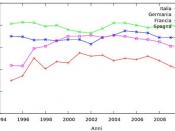Governments borrow money from investors through issuing debt securities called bonds. When a government issues bonds, it agrees to pay interest on the money that is owed to the person holding the bond. Usually, payments are semiannual; but, for purposes of this discussion, payments are assumed to be annual (and the government is assumed to be the US government). The annual interest rate is called the coupon rate. Generally, this coupon rate can be structured in two ways: fixed or floating.
As the name suggests, when a government bond carries a fixed interest rate, the government has agreed to pay a set annual interest rate for the life of the bond. Therefore, if the interest rate is fixed at 7%, then the government will semiannually pay the bond holder 7% of the remaining debt in addition to the principal payment, which is equal to the original borrowed amount divided by the number of periods.
When the government issues bonds with floating interest rates, the government has agreed to pay the principal payment in addition to a payment of interest that is based upon a fluctuating interest rate that is influenced by an agreed upon factor. Usually (and for purposes of this discussion) the interest rate is dependent upon inflation, or the Consumer Price Index (CPI). If a bond's floating interest rate is based upon the CPI, then the government has agreed to pay a set rate above the CPI. An example would be a government bond that earns a floating interest rate of 4% over the CPI. Assuming that the CPI is 3%, then a floating rate bond would pay the principal payment in addition to an interest payment equal to 7% of the remaining borrowed amount.
There are advantages and disadvantages associated with both types of interest rate...


